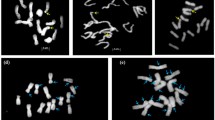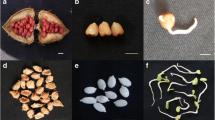Abstract
Lentil is one of the oldest protein-rich food crop with only one cultivated and six wild species. India is one important cultivator, producer and consumer of lentils and possesses a large number of germplasms. All species of lentil show 2n = 14 chromosomes. The primary objective of the present paper is to search chromosomal landmarks through enzymatic maceration and air drying (EMA)-based Giemsa staining method in five Indian lentil species not reported elsewhere at a time. Additionally, gametic chromosome analysis, tendril formation and seed morphology have been studied to ascertain interspecific relationships in lentils. Chromosome analysis in Lens culinaris, Lens orientalis and Lens odemensis revealed that they contain intercalary sat chromosome and similar karyotypic formula, while Lens nigricans and Lens lamottei showed presence of terminal sat chromosomes not reported earlier. This distinct morphological feature in L. nigricans and L. lamottei may be considered as chromosomal landmark. Meiotic analysis showed n = 7 bivalents in L. culinaris, L. nigricans and L. lamottei. No tendril formation was observed in L. culinaris, L. orientalis and L. odemensis while L. nigricans and L. lamottei developed very prominent tendrils. Based on chromosomal analysis, tendril formation and seed morphology, the five lentil species can be separated into two distinct groups. The outcome of this research may enrich conventional and biotechnological breeding programmes in lentil and may facilitate an easy and alternative method for identification of interspecific hybrids.




Similar content being viewed by others
References
Balyan HS, Houben A, Ahne R (2002) Karyotype analysis and physical mapping of 18S-5.8S-25S and 5S ribosomal RNA loci in species of genus Lens Miller (Fabaceae). Caryologia 55:121–128
Barulina H (1930) Lentils of the U.S.S.R. and other countries. Suppl. 40th to the Bull Appl Bot, Genetics and Plant Breeding, Leningrad, 265–394
Bhattacharjee SK (1951) Cytogenetics of Lens esculenta Moench var. Microsperma. Sci Cult 16:426–427
Czefranova Z (1971) Novosti Systematischeski Vyssich Rastenii 8: 184–191
de Vilmorin P (1910) Experiments on Mendelian inheritance (transl. from French). C R Acad Sci Paris 2:548–551
de Vilmorin P, Bateson W (1911) A case of gametic coupling in Pisum. Proc R Soc Lond B Biol Sci 84:9–11
Ferguson ME, Maxted N, Slageren MV, Robertson LD (2000) A reassessment of the taxonomy of Lens Mill. (Leguminosae, Papilionoideae, Vicieae). Bot J Linn Soc 133:41–59
Fukui K (1996) Plant chromosomes at mitosis. In: Fukui K, Nakayama S (eds) Plant chromosomes: laboratory methods. CRC Press, Tokyo, pp 1–18
Guerra M (2008) Chromosome numbers in plant cytotaxonomy: concepts and implications. Cytogenet Genome Res 120:339–350
Gupta PK, Bahl JR (1983) Cytogenetics and origin of some pulse crops. In: Swaminathan MS, Gupta PK, Sinha U (eds) Cytogenetics of crop plants. Macmillan India Ltd, New Delhi, pp 405–440
Gupta PK, Singh J (1981) Standard karyotype in lentil (Lens culinaris Med.) var. PL-639. LENS 8:23
Hancock JF (2004) Plant evolution and the origin of crop species, 2nd edn. CABI, Wallingford, UK
Kurata N, Omura T (1978) Karyotype analysis in rice, I. A new method for identifying all chromosome pairs. Jpn J Genet 53:251–255
Ladizinsky G (1979a) The origin of lentil and its wild genepool. Euphytica 28:179–187
Ladizinsky G (1979b) The genetics of several morphological traits in the lentil. J Hered 70:135–137
Ladizinsky G, Muehlbauer FJ (1993) Wild lentils. Crit Rev Plant Sci 12:169–184
Ladizinsky G, Braun D, Goshen D, Muehlbauer FJ (1984) The biological species of the genus Lens. Bot Gaz 145:253–261
Lavania UC, Lavania S (1983) Karyotype studies in Indian pulses. Genet Agraria 37:299–308
Levitzky GA (1931) The karyotype in systematic. Bull Appl Bot Genet Plant Breed 27:220–240
Moscone EA, Scaldaferro MA, Grabiele M, Cecchini MC, Garcia YS, Jarret R, Daviña JR, Ducasse DA, Barboza GE, Ehrendorfer F (2007) The evolution of chili peppers (Capsicum - Solanaceae): a cytogenetic perspective VI' international Solanaceae conference Eds.: Spooner DM et al. ISHS Acta Hort 745:137–169
Naithani SP, Sorbhoy RK (1973) Cytological studies in Lens esculenta Moench. Cytol 38:195–203
Nandanwar RS, Narkhede MM (1991) Intraspecific variation in karyotype of lentil. J Maharastra Agri Univ 16:24–27
Philip AD, Monika ML, Maqbool A (2007) Wild relatives and biotechnological approaches. In: Yadav SS, David LM, Philip CS (eds.) Lentil: an ancient crop for modern times, Springer 225–240
Pickersgill B (1971) Relationships between weedy and cultivated forms in some species of chili peppers (genus Capsicum). Evolution 25:683–691
Podder R, Banniza S, Vandenberg A (2013) Screening of wild and cultivated lentil germplasm for resistance to stemphylium blight. Plant Genet Resour Crop 11:26–35
Schneeweiss HW, Schneeweiss GM (2013) Karyotype diversity and evolutionary trends in Angiosperms. In: Greilhuber J, Dolezel J, Wendel JF (eds) Plant genome diversity, 2nd Vol. Springer verlag, Wien, pp 209–230
Sharma AK, Muhkopadhyay S (1963) Karyotype constancy in different strains of Lens esculentum Moench as worked out through recent techniques. Indian Agric 7:103–111
Sharma AK, Sharma A (1980) Chromosome techniques: theory and practice, 3rd edn. Butterworth’s, London
Sharma SK, Knox MR, Ellis TH (1996) AFLP analysis of the diversity and phylogeny of Lens and its comparison with RAPD analysis. Theor Appl Genet 93:751–758
Sindhu JS, Slinkard AE, Scales GJ (1984) Karyotypic analysis of Lens orientalis (Boiss.) Handle-Mazetti. Cytol 49:151–155
Sinha SS, Acharia SS (1972) Karyotype analysis in some varieties of Lens culinaris. Cytol 37:673–683
Sinha SSN, Acharia SS (1974) Cytological studies in Lens nigricans: a case of translocation heterozygote. Cytol 39:57–62
Tadmor Y, Zamir D, Ladizinsky G (1987) Genetic mapping of an ancient translocation in the genus Lens. Theor Appl Genet 73:883–892
van Oss H, Aron Y, Ladizinsky G (1997) Chloroplast DNA variation and evolution in the genus Lens Mill. Theor Appl Genet 94:452–457
Wang L, An L, Hu Y, Wei L, Li Y (2009) Influence of phytohormones and medium on the shoot regeneration from leaf of Swertia chirata Buch.-Ham Ex wall. in vitro. Afr J Biotechnol 8:2513–2517
Williams JT, Sanchez AMC, Jackson MT (1974) Studies on lentils and their variation. 1. The taxonomy of the species. Sabrao J 6:133–145
Acknowledgments
T. B. Jha acknowledges the Director and Dr. J. Kumar of Indian Institute of Pulses, Kanpur, India for providing the plant materials and Principal, Barasat Govt. College for providing basic facilities. University Grant Commission (UGC) is also acknowledged for awarding the project.
Conflict of interest
The authors declare that they have no competing interests.
Author information
Authors and Affiliations
Corresponding author
Additional information
Handling Editor: Peter Nick
Rights and permissions
About this article
Cite this article
Jha, T.B., Halder, M. Searching chromosomal landmarks in Indian lentils through EMA-based Giemsa staining method. Protoplasma 253, 1223–1231 (2016). https://doi.org/10.1007/s00709-015-0873-7
Received:
Accepted:
Published:
Issue Date:
DOI: https://doi.org/10.1007/s00709-015-0873-7




